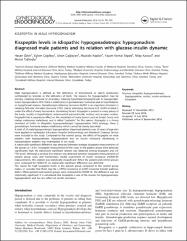| dc.contributor.author | Öztin, Hasan | |
| dc.contributor.author | Çagıltay, Eylem | |
| dc.contributor.author | Çağlayan, Sinan | |
| dc.contributor.author | Kaplan, Mustafa | |
| dc.contributor.author | Akpak, Yaşam Kemal | |
| dc.contributor.author | Karaca, Nilay | |
| dc.contributor.author | Tiğlioğlu, Mesut | |
| dc.date.accessioned | 10.07.201910:49:13 | |
| dc.date.accessioned | 2019-07-10T19:56:08Z | |
| dc.date.available | 10.07.201910:49:13 | |
| dc.date.available | 2019-07-10T19:56:08Z | |
| dc.date.issued | 2016 | en_US |
| dc.identifier.citation | Öztin, H., Çagıltay, E., Çağlayan, S., Kaplan, M., Akpak, Y. K., Karaca, N. ... Tiğlioğlu, M. (2016). Kisspeptin levels in idiopathic hypogonadotropic hypogonadism diagnosed male patients and its relation with glucose-insulin dynamic. Gynecologıcal Endocrinology, 32(12), 991-994. https://dx.doi.org/10.1080/09513590.2016.1214258 | en_US |
| dc.identifier.issn | 0951-3590 | |
| dc.identifier.issn | 1473-0766 | |
| dc.identifier.uri | https://dx.doi.org/10.1080/09513590.2016.1214258 | |
| dc.identifier.uri | https://hdl.handle.net/20.500.12511/2590 | |
| dc.description | WOS: 000390162300014 | en_US |
| dc.description | PubMed ID: 27616469 | en_US |
| dc.description.abstract | Male hypogonadism is defined as the deficiency of testosterone or sperm production synthesized by testicles or the deficiency of both. The reasons for hypogonadism may be primary, meaning testicular or secondary, meaning hypothalamohypophyseal. In hypogonadotropic hypogonadism (HH), there is indeficiency in gonadotropic hormones due to hypothalamic or hypophyseal reasons. Gonadotropin-releasing hormone (GnRH) is an important stimulant in releasing follicular stimulant hormone (FSH), mainly luteinizing hormone (LH). GnRH omitted is under the effect of many hormonal or stimulating factors. Kisspeptin is present in many places of the body, mostly in hypothalamic anteroventral periventricular nucleus and arcuate nucleus. Kisspeptin has a suppressor effect on the metastasis of many tumors such as breast cancer and malign melanoma metastases, and is called "metastin'' for this reason. Kisspeptin is a strong stimulant of GnRH. In idiopathic hypogonadotropic hypogonadism (IHH) etiology, there is gonadotropic hormone release indeficiency which cannot be clearly described. A total of 30 male hypogonatropic hypogonadism diagnosed patients over 30 years of age who have applied to Haydarpasa Education Hospital Endocrinology and Metabolic Diseases Service were included in the study. Compared to the control group, the effect of kisspeptin on male patients with hypogonatropic hypogonadism and on insulin resistance developing in hypogonadism patients was investigated in our study. A statistically significant difference was detected between average kisspeptin measurements of the groups (p < 0.01). Kisspeptin measurement of the cases in the patient group were detected significantly high. No statistically significant relation was detected among kisspeptin and LH/FSH levels. Although a positive low relation was detected between kisspeptin measurements of patient group cases and homeostasis model assessment of insulin resistance (HOMA-IR) measurements, this relation was statistically insignificant. When the patient and control groups were compared for HOMA-IR, no statistically significant difference was detected. The reason for high kisspeptin levels in the patient group compared to the control group makes us consider that there may be a GPR54 resistance or GnRH neuronal transfer pathway defect. When patients and control groups were compared for HOMA-IR, the difference was not statistically significant. It is considered that kisspeptin is one of the reasons for hypogonatropic hypogonadism and has less effect on insulin resistance. | en_US |
| dc.language.iso | eng | en_US |
| dc.publisher | Taylor & Francis Ltd | en_US |
| dc.rights | info:eu-repo/semantics/openAccess | en_US |
| dc.subject | Glucose | en_US |
| dc.subject | Idiopathic Hypogonadotropic Hypogonadism | en_US |
| dc.subject | Insulin | en_US |
| dc.subject | Insulin Resistance | en_US |
| dc.subject | Kisspeptin | en_US |
| dc.title | Kisspeptin levels in idiopathic hypogonadotropic hypogonadism diagnosed male patients and its relation with glucose-insulin dynamic | en_US |
| dc.type | article | en_US |
| dc.relation.ispartof | Gynecologıcal Endocrinology | en_US |
| dc.department | İstanbul Medipol Üniversitesi, Tıp Fakültesi, Dahili Tıp Bilimleri Bölümü, İç Hastalıkları Ana Bilim Dalı | en_US |
| dc.authorid | 0000-0002-3636-3853 | en_US |
| dc.identifier.volume | 32 | en_US |
| dc.identifier.issue | 12 | en_US |
| dc.identifier.startpage | 991 | en_US |
| dc.identifier.endpage | 994 | en_US |
| dc.relation.publicationcategory | Makale - Uluslararası Hakemli Dergi - Kurum Öğretim Elemanı | en_US |
| dc.identifier.doi | 10.1080/09513590.2016.1214258 | en_US |
| dc.identifier.wosquality | Q3 | en_US |
| dc.identifier.scopusquality | Q2 | en_US |


















